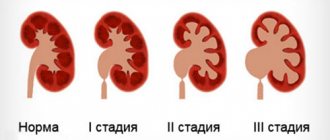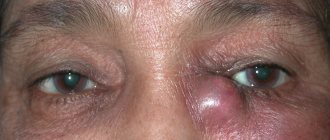Causes and symptoms
Pregnancy is an absolutely natural, but quite complex process. As a result, the entire body undergoes changes. The amount of fluid in the tissues of the female body during this period increases by 4-9 liters, with a norm of 7 liters. This is mainly due to the release of amniotic fluid and the formation of the placenta.
Expert opinion
The increase in fluid during pregnancy is physiologically determined; therefore, normally this process is not pathological. It is usually caused by an increase in progesterone in the blood.
Vascular surgeon, phlebologist
Osipova Ekaterina Yakovlevna
Changes also occur in water-salt metabolism. From the beginning of pregnancy, the endocrine and urinary systems are reconstructed, and the woman’s body begins to actively store water and sodium salts. Physiological swelling may form due to the fact that sodium, preventing dehydration, attracts water to the tissues.
Often the reason why leg swelling occurs in the evening, during pregnancy, is an inactive lifestyle, sedentary or standing work. Stagnation occurs, and as a result, swelling, heavy leg syndrome and pain appear.
Causes of edema during pregnancy
Heat and high humidity in summer can also cause severe swelling during pregnancy. Under the influence of these factors, the blood vessels in the lower extremities dilate and fluid accumulates.
!
Psychosomatic factors can also cause edema.
Physiological swelling of the legs by the 9th month (at 38 weeks) of pregnancy is present in at least 75-80% of women. This is not dangerous, as this swelling goes away quickly.
But there are edemas that are a consequence of other reasons that pose a potential danger to the mother’s body and the normal course of pregnancy:
- cardiac pathology;
- renal pathology;
- varicose veins;
- allergic reactions;
- toxicosis (Toxicosis) in later stages (preeclampsia).
Cardiac edema
Pathological edema caused by heart disease is called cardiac edema. They are characterized by symmetrical localization and spread upward. Thus, swelling of the ankles of both legs gradually, as pregnancy progresses, from the distal part of the limb reaches the knee. Then they can spread higher, up to the face. They also vary in degree of density; they can be soft, or they can be quite dense. The skin becomes loose and elastic. When such severe swelling of the legs occurs during pregnancy, it is necessary to urgently seek medical help.
Edema due to renal pathology
Renal edema primarily appears on the eyelids and feet. In the absence of proper treatment, internal (hidden) swelling may also occur. But more often, uniformly distributed large swelling occurs not only of the face and legs, but of the entire body. During pregnancy, this is simply unacceptable, due to the harm to the health of the mother and child.
The presence of edema can be determined by palpation and the McClure-Aldrich test, the so-called blister test. Using this method, water metabolism disorders are determined. To do this, use a saline solution, which is injected into the inner part of the forearm. It should resolve within 1 hour; the faster this happens, the more pronounced the swelling. This test is currently practically not carried out due to tissue trauma.
Swelling due to varicose veins
Swelling on the leg
Due to varicose veins, which, like all pathologies, was most likely present before pregnancy and only worsened during pregnancy, swelling of the lower extremities appears. This type of edema depends on the sitting or standing position of the body, the time of day, and the mode of work and rest.
As a result of increased blood flow during pregnancy, the veins become overfilled and deformed, and as a result, the right or left leg swells. Asymmetrical swelling is a distinctive feature of edema due to disorders in the venous system of the lower extremities. In this case, the swollen area of the skin becomes thinner, hair may disappear on it, and pain occurs on palpation.
Expert opinion
In addition to the increased blood supply to the vessels observed during gestation, it is worth considering the increase in pressure exerted on the lower extremities due to weight gain. For this reason, multiple pregnancies or carrying a large fetus are often accompanied by the development of varicose veins.
Vascular surgeon, phlebologist
Osipova Ekaterina Yakovlevna
Often such swelling begins to occur in the early stages. In the second or third trimester of pregnancy, the enlarged uterus compresses the venous vessels in the pelvis, and then the prevalence of varicose veins becomes more widespread - the hemorrhoidal vein is affected, and varicose veins of the vulva and labia appear. Therefore, it is important to control swelling in the final stages of pregnancy, from the 35th week in particular.
The consequences of such swelling are very unpleasant, so you should not ask yourself why you swell during pregnancy, but should consult a doctor. During the period of gestation, you need to take care of yourself with special pedantry and respond to all the alarm signals that the body gives.
Swelling as a result of allergic reactions
In anticipation of the birth of the child, the body of the expectant mother works in a completely different mode. In particular, the immune system can give a negative reaction to various factors that reduce it. This can be pet hair, dust, pollen from flowering plants, all kinds of food additives, cosmetic components, etc.
!
An allergic reaction can be mild or severe.
The pathological process in different cases can affect different systems of the body, and accordingly the localization is also different. Also, allergies can manifest themselves in completely different ways. Mild allergic reactions are considered:
- problems with ENT organs (rhinitis, sinusitis, sinusitis);
- problems with the organs of vision (conjunctivitis);
- skin manifestations (dermatitis, itching, peeling).
Severe allergic reactions are considered to be:
- anaphylactic shock;
- Quincke's edema
- large-scale urticaria (generalized).
All three reactions can cause serious health damage. Quincke's edema is quite dangerous. It can damage many internal organs. Characterized by swelling of the mucous membranes and skin. Swelling in the ankle and arm joints is possible. If such reactions occur, urgent hospitalization is required.
Edema due to gestosis
Gestosis is a complication that appears in late pregnancy. The peak occurs at 36-39 weeks. Swelling occurs, blood pressure rises, and the functioning of the urinary system deteriorates (increased protein content in the urine). The first signs of gestosis are detected from the 18th week. Therefore, it is extremely important to be observed during pregnancy at the antenatal clinic so that the gynecologist can timely diagnose a possible complication based on a number of signs.
is not responsible for the accuracy of the information presented in this video clip. Source - Mom's School
When to contact a gynecologist
The most common signs of edema are that rings and straps on shoes begin to put a lot of pressure and cause discomfort. In this case, it is recommended to buy looser shoes and not wear rings until the end of pregnancy. Slight swelling of the face, upper and lower eyelids usually appears in the morning and goes away on its own in the evening. You should consult a doctor if:
- sudden weight gain, more than 500 grams per week;
- if swelling does not go away during the day;
- numbness, tingling in swollen hands or feet;
- if it is difficult or impossible to bend your fingers, and it hurts to step on your feet;
- shortness of breath, rapid heartbeat.
You can check for swelling by pressing on the skin with your finger. If there is no trace left, everything is fine. If there remains a pale pit that is slowly leveling out, you need to see a doctor.
Treatment of edema during pregnancy
Many women, in search of an answer to the question of how to remove swelling in the legs during pregnancy, use an online forum where they can find reviews about this or that treatment method. Of course, this method of exchanging information is quite popular now. But! There is no need to resort to self-medication, especially during pregnancy.
If a pregnant woman is found to have pastosity, then at this stage her condition requires more attention from the supervising gynecologist.
If swelling does appear, then, first of all, it is necessary to establish the cause of its occurrence; only a doctor can do this. After the examination and examination, he will tell you how to relieve swelling. During pregnancy, the most important thing is not to harm the baby.
!
Experts try not to resort to drug treatment if possible.
It is worth noting that during pregnancy no one can guarantee a 100% result in the fight against swelling. Therefore, any specialist will treat edema during pregnancy, late or early, based on their experience and medical recommendations.
In some extremely rare cases, the doctor prescribes diuretic synthetic drugs and treatment is carried out in a hospital under the supervision of specialists. Such drugs have a number of contraindications and have a negative effect on the fetus. Therefore, they try to use such drugs not in the early stages, but to eliminate swelling of the legs, only at 37-39 weeks of pregnancy under constant medical supervision. There are also homeopathic analogues of synthetic diuretics.
One of the most effective ways to treat swelling and prevent complications of varicose veins is the use of anti-embolic compression stockings. It has compression class 1, the pressure it produces is 18-21 mm Hg. It is prescribed during pregnancy, during childbirth and for the entire period of stay in the maternity hospital. Only a doctor prescribes the class of compression hosiery in each individual case.
Most often, simultaneously with the prescription of medical compression hosiery, the doctor recommends the use of external agents - venotonic cream, ointment or gel. Preference is given to natural products that have a light formula; they are absorbed faster and do not leave greasy marks on either the skin or clothes.
NORMAVEN® foot cream has a positive effect on swelling; it can be applied under therapeutic knitwear, it does not destroy the fibers of the fabric. The safety of the cream during this period of a woman’s life has been clinically proven. Approbation and clinical studies of this product were carried out over 4 months. During this time, the patients participating in the testing of the cream noted a noticeable reduction in the vascular pattern on the legs, which in turn will prevent the development of varicose veins. Elimination of the feeling of heaviness in the lower extremities, disappearance of evening cramps and overall improvement in the general condition of the legs is noted already from the first month of use. Due to no identified side effects, this remedy can be used in different periods: when swelling of the legs occurs during pregnancy, both in the later stages and in the early stages. This means that it can be used for swelling of the legs and at 36 weeks of pregnancy.
!
You can supplement the treatment prescribed by your doctor using folk remedies for leg swelling during pregnancy.
Basically, infusions of various medicinal herbs and rhizomes with a diuretic effect are taken. Bearberry and birch leaves, parsley roots and horsetail, and lingonberry leaves are actively used. The use of kidney tea (orthosiphon herb) is common. Its warm infusions should be drunk 3-4 times a day before meals. The course is no more than 1 month. It should be remembered that it is possible to eliminate swelling using folk remedies only with the permission of the doctor monitoring the progress of pregnancy.










